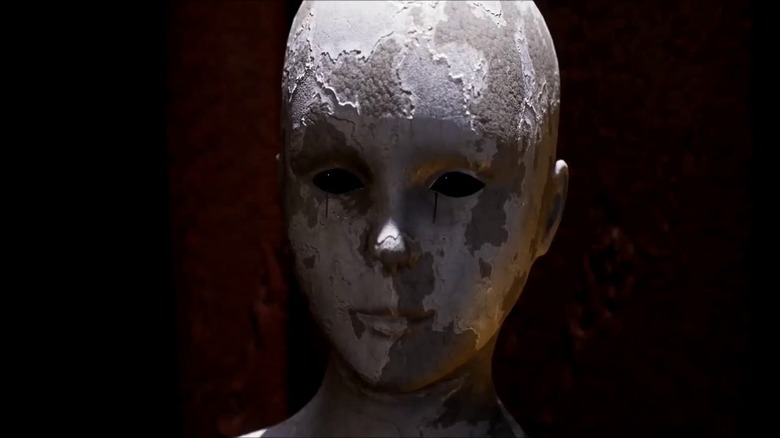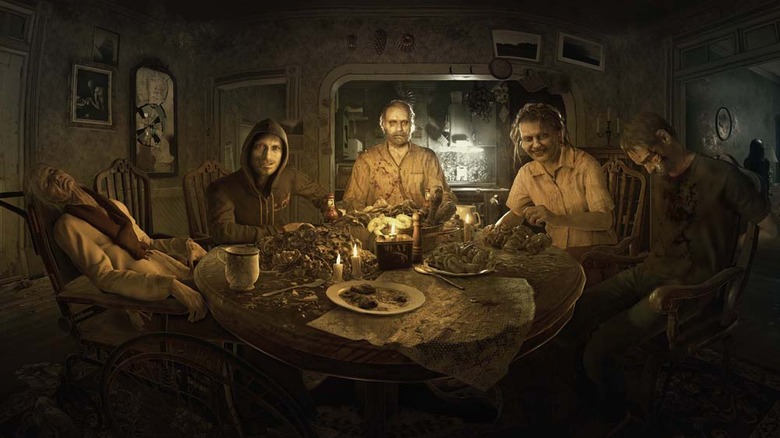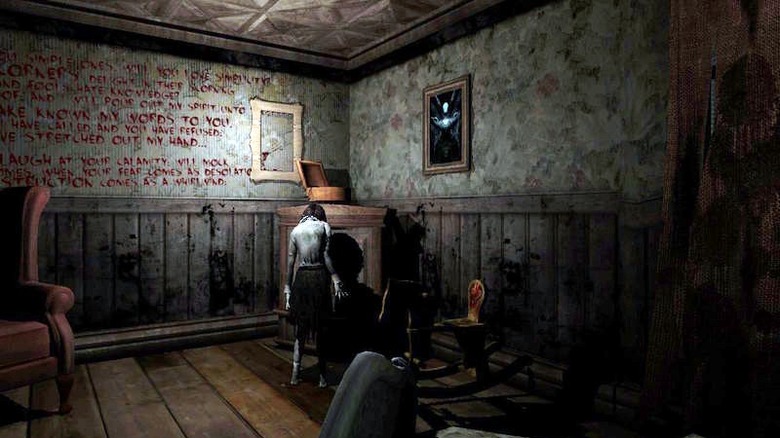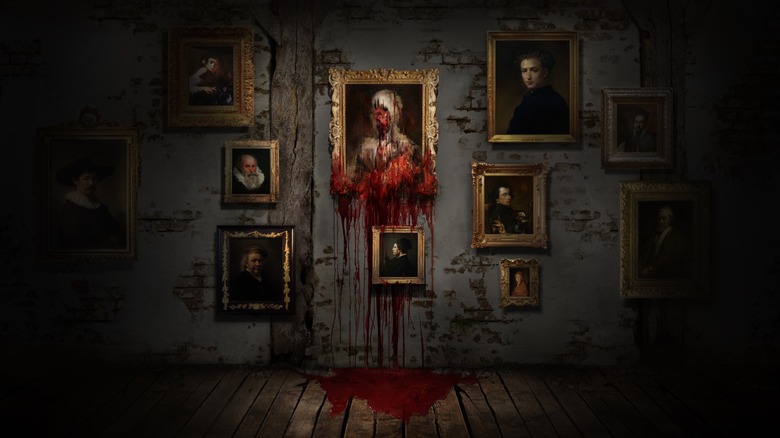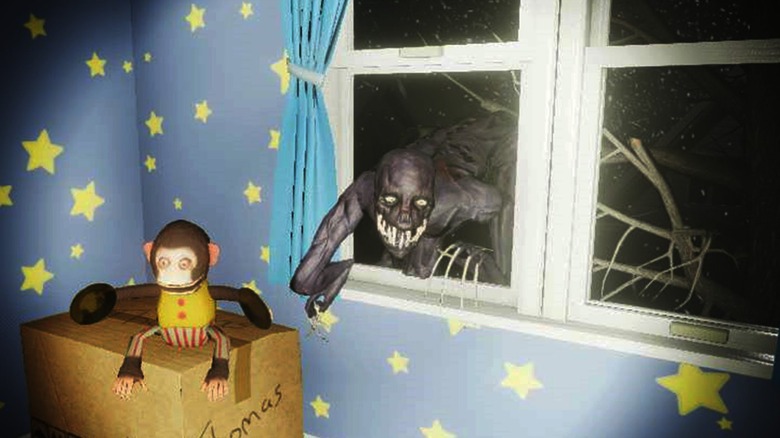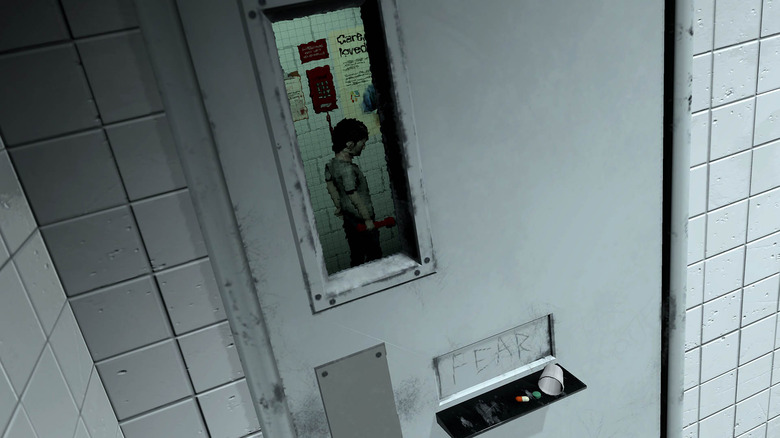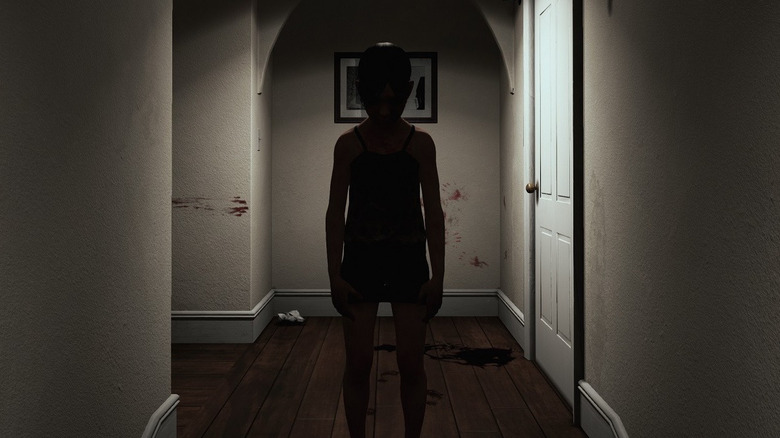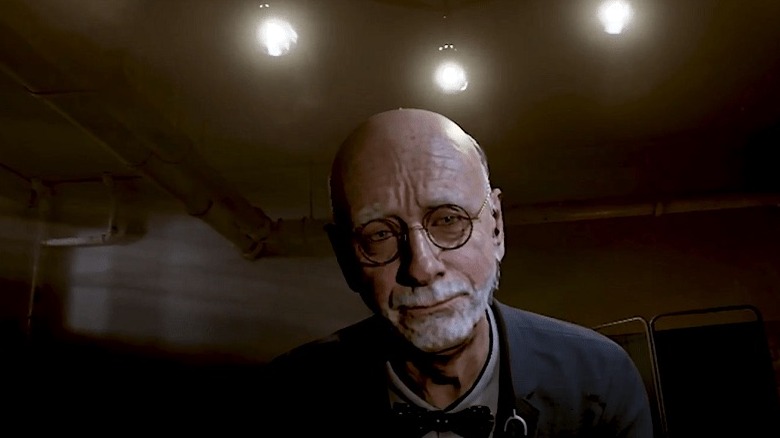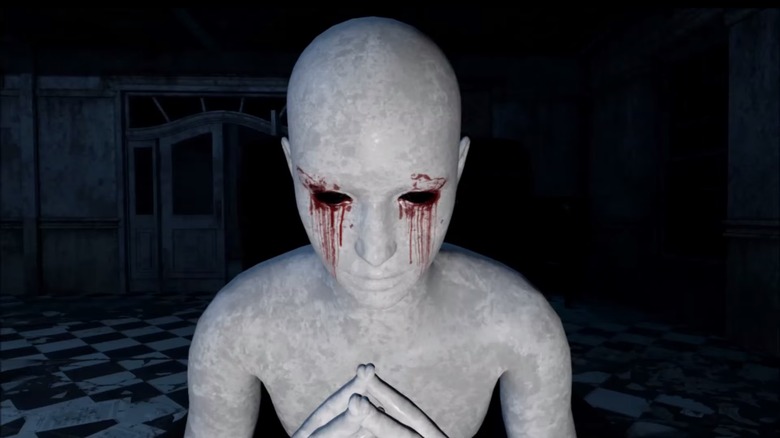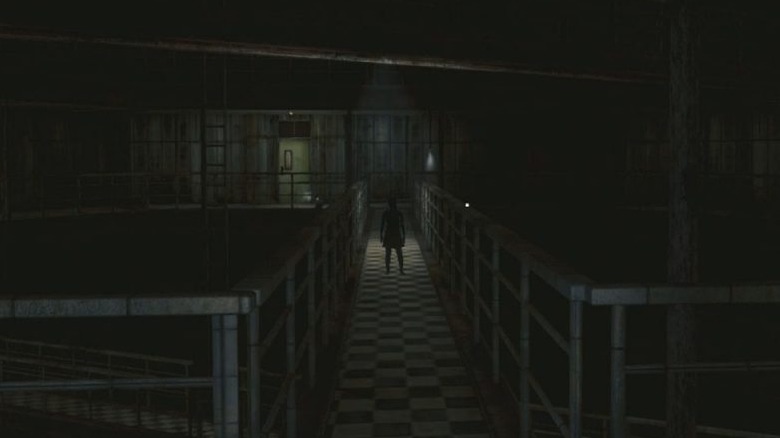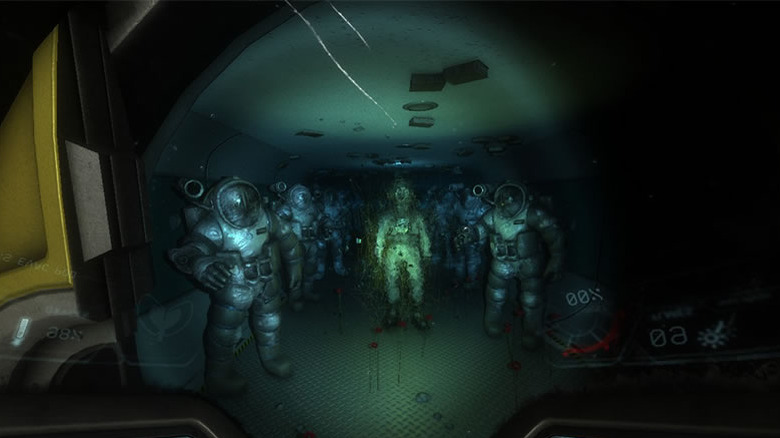The Most Terrifying Games To Play In VR
The world of gaming is constantly changing, bringing with it new ways for the virtual world to terrify horror fans. In the past several years, virtual reality has gone from a clunky novelty to an immersive environment with a plethora of possibilities. While the medium is still testing which use cases work best for it, it has become apparent that the technology is brilliantly suited for horror games.
Everyone has a different defense mechanism when faced with terror. Some of the most obvious and typical include covering your eyes or plugging your ears. The brilliance of VR is that it takes away the player's ability to hide from what they're experiencing and drops them right in the middle of a nightmare. The complete immersion offered by VR is paired with the fact that people with varying degrees of gaming skill and physical ability can participate. The inclusive nature of VR, its ability to envelop players, and the imaginative and terrifying landscapes created by developers all combine to make the perfect storm of horror. Here are the most terrifying games to play in VR, for those brave enough to try them.
Resident Evil 7 gets up close and personal with the Baker family
Capcom's Resident Evil franchise has always been known for its atmospheric scares and envelope-pushing survival horror situations. While most of the Resident Evil games are praised for their impressive scares, Resident Evil 7: Biohazard takes things to a whole new level.
Ultra-realistic settings are one of the things that sets VR games apart. But that's not always an appealing prospect when the setting you're in is the decaying, decrepit Baker home. This VR experience is made even more horrific with the immersive gross-out scenes and constant tension. Throughout the game, the player is forced to solve intricate puzzles that require concentration and focus. Unfortunately, focusing gets pretty hard when you're worried about one of the Bakers catching you. The persistent feeling of unease, terror, and disgust make for a heart-rate-raising playthrough that many players may not be able to complete if their nerves take over.
Affected: The Manor promises an immersive and focused scare-fest
People love being scared. There's something about being stuck in a scary situation that you know won't harm you that exhilarates thrill seekers. Fallen Planet Studios' Affected: The Manor offers players something akin to a walking simulator gone horribly wrong.
Dropping the player right into the thick of things, Affected quickly escalates the tension with jump scares and the experience of walking through a haunted house while being stalked by a terrifying and very vocal entity. Notably, this VR title features only minimialist mechanics. Instead distracting you with puzzles to solve or maps to complete, you are simply left to enjoy — if that's the right word — the game and environment. Because you can't die and replay a section, you're always completely focused on what is in front of you and experiencing it for the first time.
Fallen Planet Studios has said that their goal with Affected was to create an immersive atmosphere for players, free from the distractions of typical game mechanics. Never has a walking simulator been so horrifying.
Experience the unstable mind of the painter in Layers of Fear
The 2016 psychological horror game Layers of Fear by Bloober Team was hailed as an immersive and atmospheric playthrough when first released. Once the VR version was completed, the game realized its full potential for an all-encompassing experience that could truly utilize the gorgeous level design fans had loved since the original game's release.
The already psychedelic nature of Layers of Fear did a great job of keeping players off balance and slightly unsure of what to believe. But actually being in the ever-changing environment took the atmosphere to a whole new level. Layers of Fear is a game that was made for VR, with its haunted-house-like quality and ability to draw the player in. Captivating sound design and stunning visuals make the game a unique piece of art with a dark and sinister tension that never quite leaves throughout the entirety of the playtime.
Relive your childhood fears in Boogeyman
Survival horror is only as good as its ability to strike a chord with its audience. Playing on childhood fears is one of the quickest ways to utilize a universal experience and pull players into the atmosphere. Primal fears of the dark and the unknown are what pieces together the horror of Barry McCabe's Boogeyman.
The setup of the game is typical enough: you are a child in his room at night, scared of the dark and worried that there might be a monster under your bed. The catch is that you actually do have a monster trying to get to you, and it's not just under your bed, it's outside the window, in the vent in the ceiling, in your closet, and outside your door. With game mechanics and gameplay very similar to Five Nights at Freddy's 4, Boogeyman takes the FNAF concept in a different direction with hints of a backstory that the family who lived in the house before you left for a sinister reason.
Jump scares, strategy, and the need to keep cool under pressure make Boogeyman a fantastic horror survival experience for anyone brave enough to face their childhood fears.
A simplistic concept proves terrifying in A Chair in a Room
It's not uncommon to start a game as an unnamed protagonist with no memory of who they are or how they got there. This concept places the player directly into the action in 2016's A Chair in a Room from Wolf & Wood. Given minimal clues to piece your past together, players must solve puzzles in various settings to understand their character.
While there are jumpscares present in A Chair in a Room, the game doesn't rely on these alone to bring the horror. Players will find themselves in a smart horror game with an actual involved narrative to discover and a surprisingly effective use of the room scale tool. The fact that the game scales its size according to the available space the player has to play in, means that this isn't a typical seated VR experience. Players will actually walk around the spaces they find themselves in, making the immersion that much sharper, and the scares that much more terrifying.
Hyper-realistic graphics make Paranormal Activity: The Lost Soul completely immersive
One of the things that makes a VR game frightening is the feeling that you're situated in a familiar environment. While a surreal VR game may be a great way to utilize the medium for a unique experience, something about being in a hyper-realistic domestic location makes a game a little too real for comfort. In VRWERX's 2017 VR game Paranormal Activity: The Lost Soul, players explore a seemingly empty home. This typical domestic space subtly puts the player off-balance with its familiarity.
While the jump scares are plentiful, the scariest thing about Paranormal Activity: The Lost Soul is the randomization engine used to give each player a unique experience. This means watching multiple Let's Play videos of the game won't necessarily prepare you for how you'll experience the horror. Because of the random generation of jump scares and clues, each player has to search the dark and foreboding game as if they're the first person to play it. Combined with the heavy atmosphere, demonic undertones, and familiar setting, Paranormal Activity: The Lost Soul is a game that is sure to stick with players, long after they've turned off the screen.
The Inpatient uses the player's voice as a mechanic
With the growing popularity of horror games in the VR world, it's difficult to find games that stand apart as a unique experience. While jump scares and heavy atmosphere are trademarks that players have come to expect from their VR gaming, Supermassive Games' psychological horror game The Inpatient takes things to an ingenious new level. The common trope of being an unknown person in a mental hospital without a memory of where you came from doesn't harm the game's originality.
While most VR horror games tout immersion as a big selling point, The Inpatient actually completes the player's immersion by allowing them to choose their gender and skin color, so when they look down at their virtual hands and feet, they're looking at something familiar. In addition to the personalization of your avatar, The Inpatient has the player use their voice to recite different dialogue options as a way of choosing what your character will say. Physically speaking to NPCs around you and having them respond is a level of immersion that puts The Inpatient at the forefront of VR horror games.
Doors of Silence is a deadly game of hide and seek nobody wants to be stuck in
The Prologue, the first installment of Blackbite Interactive's horror saga Doors of Silence, proves to be a terrifying first chapter. Starting out in an office in, what looks like, an underground bunker, players are dropped straight into the horror. Unsure of who you are or where you are, you must navigate the nightmare space and investigate the seemingly empty buildings.
The random appearances of statuesque figures in various positions immediately lets players know that they aren't in this facility alone. Even with some of the statues bleeding from the eyes and others wordlessly instructing the player to remain silent, a still more sinister threat soon presents itself, entangling you in a game of cat and mouse.
The lack of a consistent soundtrack and sparse use of sound effects creates a constant note of tension that is ready to snap at the slightest indication of a jump scare. Once the game gets into its full-fledged chase sequences, the silence is gone and you're left with the horrifying realization that you may not make it out alive.
Araya is hospital horror like you've never seen it
Culture is a big influencer in the world of horror. What seems frightening to someone in North America may be mundane in Japan. This is most obvious in American remakes of Japanese and Korean horror films. Often in the adaptation, the setting and circumstances are changed to better suit their target audience. Because of this, many gamers are used to experiencing horror from a Western point of view. The brilliant appeal of Araya from MAD Virtual Reality Studio, is the fact that the setting will seem very familiar to Thai players and very "other" to those familiar with Western horror.
While the setting of Araya could have worked as a disadvantage for its global appeal, the developers manage to create something that is traditionally scary for Thai players and frighteningly foreign to a Westerner. Everything from the level design to the jump scares were meticulously crafted by the developers to cater to a wide audience, while introducing Westerners to a new kind of scare. Araya will lead players through a ghostly game of hide and seek that gets more ominous with each chapter, as you try to unravel the story of Araya's untimely demise through the perspective of three different protagonists.
Silent isolation in Narcosis sets tension high throughout
When Narcosis was first released in 2017 by Honor Code, Inc., the game's most suffocating character was the sheer isolation of being trapped in the ocean in a quickly declining situation. Somewhat reminiscent of BioShock in its grandiose setting and subtle horror, the quiet build up of tension of Narcosis is what starts the player's heart rate rising.
In a game that doesn't rely on constant jump scares to bring tension to the situation, any small sound, movement, or perceived change in environment is enough to set off a fear response that would make even the most poised gamers run for cover. The decreasing stability of the avatar's mind combined with the panic-inducing fact that light and oxygen are severely limited in the destroyed underwater facility, make Narcosis a different kind of VR horror that sets itself apart from all of the competition.

